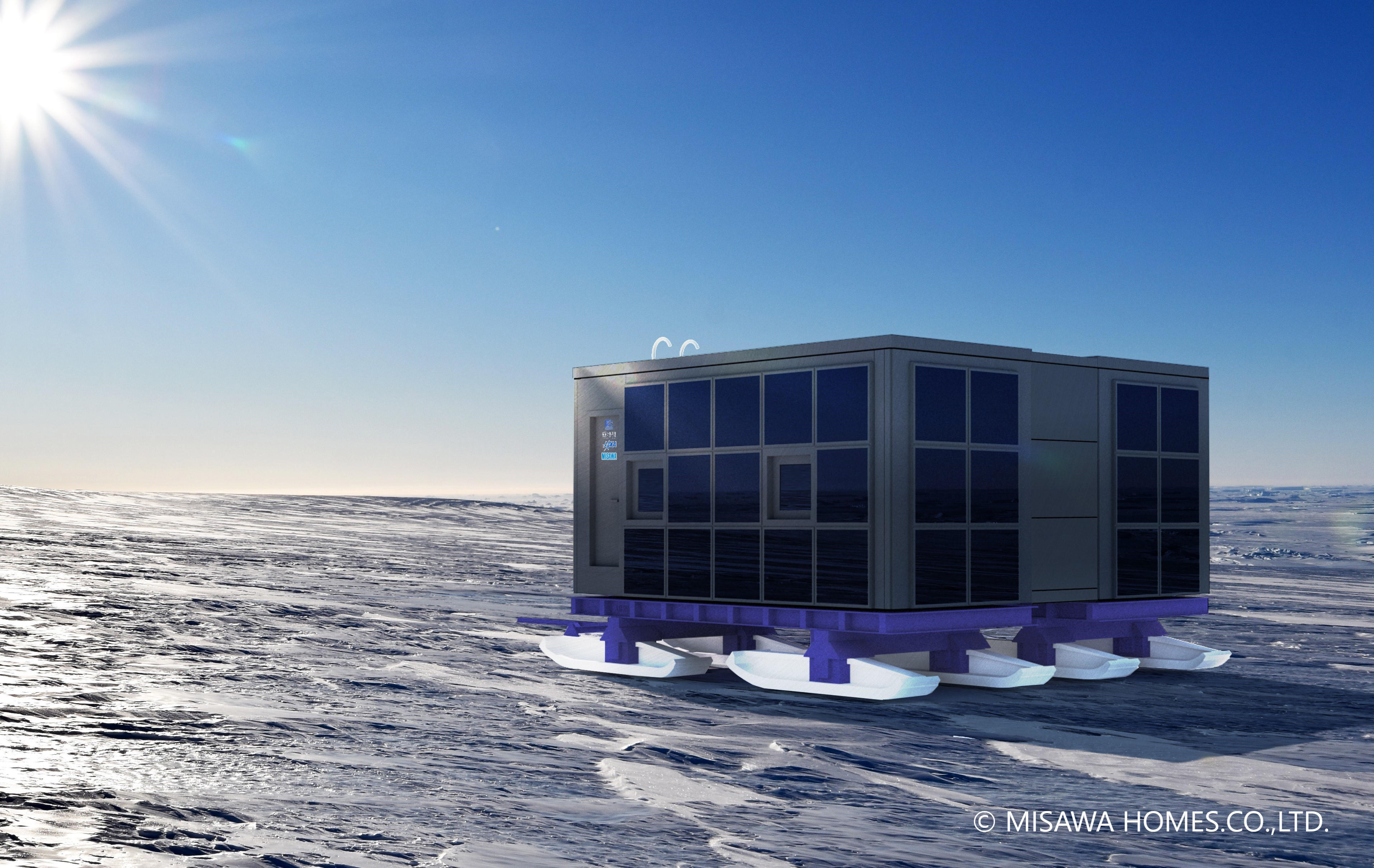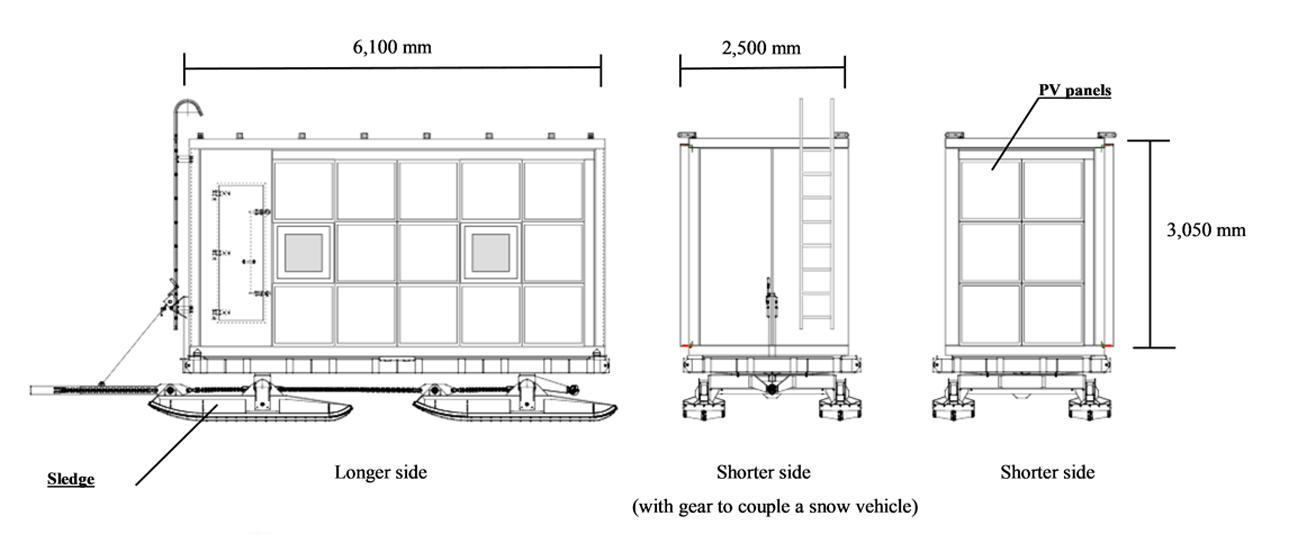A Joint Project of JAXA, NIPR, Misawa Homes, and MHIRD
Demonstration Test of Antarctica Mobile Station Unit
August 26, 2019 (JST)
National Research & Development Agency
Japan Aerospace Exploration Agency (JAXA)
Inter-university Research Institute Corporation Research Organization of Information and Systems
National Institute of Polar Research
Misawa Homes Co., Ltd.
Misawa Homes Institute of Research and Development Co., Ltd.
- A demonstration test will be conducted with the aim of developing a sustainable housing system that withstands the extreme environment of Antarctica.
- The test will verify simplified construction, optimized energy based on a natural energy system, monitoring sensors, and other technologies developed for the unit.
- The goals of the joint research of the four organizations are to develop future-oriented housing, a station in Antarctica, and a manned base on the moon.

Graphic image of Antarctica mobile station unit*1
The Japan Aerospace Exploration Agency (JAXA, President: Hiroshi Yamakawa), National Institute of Polar Research (NIPR, Director-General: Takuji Nakamura), Misawa Homes Co., Ltd. (Misawa Homes, President and CEO: Masashi Isogai), and Misawa Homes Institute of Research and Development (MHIRD, President: Katsuyuki Chihara) will conduct a demonstration test aimed at developing a sustainable housing system that withstands an extreme environment, at the Syowa Station in Antarctica from February 2020.
| *1: | A graphic image of the two units connected |
|---|
【Background of the demonstration test】
When JAXA solicited research project proposals for its Space Exploration Innovation Hub Center in 2017*2, a proposal from Misawa Homes and MHIRD to develop technology for simplifying construction and new sustainable housing systems with autonomous energy circulation was adopted.
JAXA, Misawa Homes and MHIRD have ever since worked together to create future-oriented, terrestrial housing and apply technologies developed for such housing to building manned bases on the moon and other planets. These technologies, including simplified construction, natural energy system, and monitoring sensors, are essential for manned bases in the outer space. To verify and enhance the reliability of these technologies, the three organizations have decided to conduct a demonstration test in an extreme environment that requires similar technologies: Antarctica. They have chosen the Syowa Station as the test field, created the Antarctica mobile station unit*3, and proposed to NIPR, an research organization responsible for the management of the Syowa Station, that the housing unit demonstration test in the polar region be adopted as an open research program*4 of the 61st Japanese Antarctic Research Expedition.
Since its establishment in 1957, for the Syowa Station, robustness of the buildings that withstands the harsh environment of Antarctica, as well as simplified construction that allows even members who are not construction experts to construct buildings with ease during short summer, have always been an issue. For this reason, NIPR considered that the technological elements of the unit would contribute greatly to the future station construction and adopted the proposal for the demonstration test of the Antarctica mobile station unit. This is how NIPR, JAXA, Misawa Homes, and MHIRD have joined together to conduct the demonstration test at the Syowa Station.
| *2: | JAXA was entrusted by the Japan Science and Technology Agency to issue a request for research proposals for the innovation hub construction support (Open Innovation Hub for Expanding Humanosphere and the Domain of Human Activity through Solar System Frontier Development) and established the Space Exploration Innovation Hub Center in 2015 for the purpose of fusing superior terrestrial technologies and space exploration technologies to promote, not just space exploration but also, the creation of new industries and the development of industry as a whole in Japan. |
|---|---|
| *3: | Misawa Homes has cooperated with the construction of the Japanese station in Antarctica since 1967. The company’s buildings are highly industrialized and designed in a way that allows even expedition members who have no construction experiences to construct them within a short period. The buildings are also capable of withstanding the harsh natural environment in Antarctica. |
| *4: | Open research programs allow researchers from universities and other institutions to utilize the Syowa Station, Antarctic research vessel Shirase, and other polar region observation platform and conduct their own research by making the maximum use of scientific value of Antarctica. They can concentrate on their research within a relatively short period and without being bound by the expedition plan. |
【Overview of the demonstration test】
1. Outline of Antarctica mobile station unit
| Dimension | :approx. 6,100 mm × 2,500 mm × 3,050 mm; floor area: approx.11.82 m2 Two units will be connected to expand the floor area to approx. 32.88 m2. |
|---|---|
| Structure | :steel unit construction + wooden adhesive composite panels (120 mm thick) |
| Exterior wall materials | :Galvalume, photovoltaic (PV) modules |
| Assumed environment for the demonstration test | :annual average air temperature -10.4˚C; minimum air temperature -45.3˚C; maximum instantaneous wind speed 61.2 m/s, etc. |
| Other | :Movable on sledges Installed with safety sensors for residents |

Elevational views of Antarctica mobile station unit
2. Details of verification
The demonstration test will verify the three features of the unit specified below. The test will enable Misawa Homes and MHIRD to obtain data useful for their production of units and development of future-oriented housing, NIPR to confirm the mobility and functionality of the unit, and JAXA to provide technical assistance for and analyze verification data of the unit and apply the findings to the construction of manned bases.
| (1) | Flexibility in the expansion/contraction of the structure The two units, each with an opening, ventilation equipment, electric wiring, interior and exterior materials, PV modules, etc., will be coupled together on site with a joint space in between to expand the living space. The two units will then be separated. During these expansion and contraction processes, it will be verified that the unit can be constructed with ease and that the constructing jigs and operational support sensors developed for the unit will work effectively in Antarctica. |
|---|

Graphic image of Antarctica mobile unit moving on ice sheet
| (2) | Optimized use of energy The unit will be equipped with a natural energy system that is built on photovoltaic generation, heat collection and storage, and other technologies and designed to achieve optimum use of heating energy within the unit. The demonstration test will verify the effect of this system. The unit is also provided with additional insulation mainly through 120-mm thick wooden panels, highly insulated panels to achieve the target UA value*5 of 0.20 W/m2K. This figure is far lower than 0.4 W/m2K, the standard UA value set for net-zero energy houses (ZEH)*7 in cold regions in Japan (Hokkaido and a part of the Tohoku region*6), and represents Japan’s highest-level insulation performance. The energy-saving performance of these insulation technologies will be verified. |
|---|
*5: The UA value or average heat transmission coefficient of the envelope is an indicator of insulation level of housing.
*6: Regions classified as 1 and 2 in the energy conservation standards for housing and buildings
*7: Standard newly-build houses in which annual net consumption of primary energy is almost zero
| (3) | Monitoring sensors The unit will be installed with various sensors that help protect the safety of residents, such as ones to measure temperature and humidity and detect CO2 and fire. These monitoring sensors will be tested to monitor the conditions of the unit on a real-time basis and verify that they will help enhance the safety and comfort of the living space. |
|---|
3. Schedule until demonstration test
<2019>
| From July | :The residential units are currently being manufactured at Misawa Homes’ Nagoya Factory. |
|---|---|
| Late October | :The Antarctica mobile unit will be unveiled. The four organizations will hold a joint press conference (subject to change). |
| November | :The units will be loaded onto Antarctic research vessel Shirase in the Port of Tokyo and transported to the Syowa Station. |
<2020>
| January | :The units will arrive at the Syowa Station. |
|---|---|
| February to September | :Demonstration test at the Syowa Station. |
4. Future developments
<NIPR and Misawa Homes>
After the demonstration test at the Syowa Station, the Antarctica mobile station unit will be transported to Dome Fuji, located inland the Antarctic continent and 3,800 meters above sea level and used as the residential space (max. capacity of 18 people) for the third Dome Fuji deep ice coring project. The sensors will continue to be used for monitoring the conditions during the project and the data will be utilized for future construction of stations in Antarctica.
<JAXA, Misawa Homes, and MHIRD>
The achievements of the joint research will be utilized to develop future-oriented, terrestrial housing and a lunar manned base.